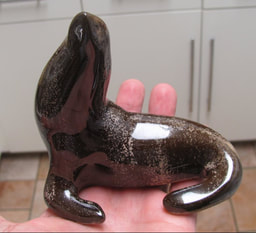Words of the Week
Bisque Firing: the act of pre-firing clay without glaze to create a porous and durable ceramic capable of accepting a glaze. The finished pre-glazed product may be known as bisque ware or more simply a biscuit.
Ceramic: of or relating to the manufacture of any product (such as earthenware, porcelain or brick) made essentially from a nonmetallic mineral (such as clay) by firing at a high temperature.
Crazing: is the appearance of a web of small hairline cracks on the surface of a glazed piece of pottery. The cracks only run as deep as the glazing, so the body underneath normally remains intact. Crazing can occur during the firing process or afterwards and is caused when too much tension is applied to the glaze.
Dipping: is the process of submerging pottery in a vat of thin glaze for 3 to 5 seconds before taking it out to dry. Dipping is the most reliable way to produce an even layer of glaze. An alternative to dipping is brushing on the glaze.
Glaze: is a liquid suspension of finely ground minerals that are applied onto the surface of bisque-fired ceramics. After the glaze dries, the ceramic item is placed into a kiln and fired at a temperature where the glaze ingredients melt together and form a shiny surface.
Kiln: an oven, furnace or chamber commonly heated by electricity, gas or wood that uses heat to turn clay into a ceramic. This process is known as firing.
Pottery: Decorative and/or functional objects made of clay, hardened with heat. Pottery can be subdivided into three main types: earthenware, porcelain and stoneware.
Slip: A cream-like mixture of clay and water used in the process of producing ceramic objects by means of pouring the slip into a mould.
Slip Casting: a ceramic forming technique which uses slip poured into a mould which is then placed aside to set a thin layer of clay against the interior walls of the mould. The excess is then poured off and the mould is separated to remove the cast piece.
Stoneware: a strong, non-porous pottery made from clay fired at very high temperatures (between 2000°F - 2400°F). The result is a stone-like waterproof ceramic which is resistant to liquids even without glazing.
